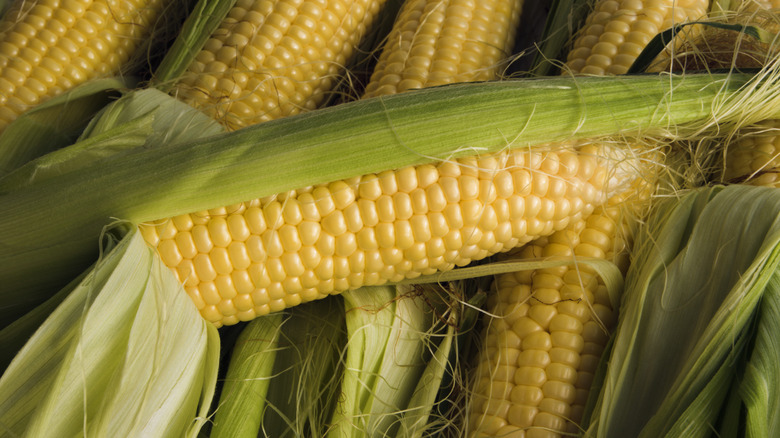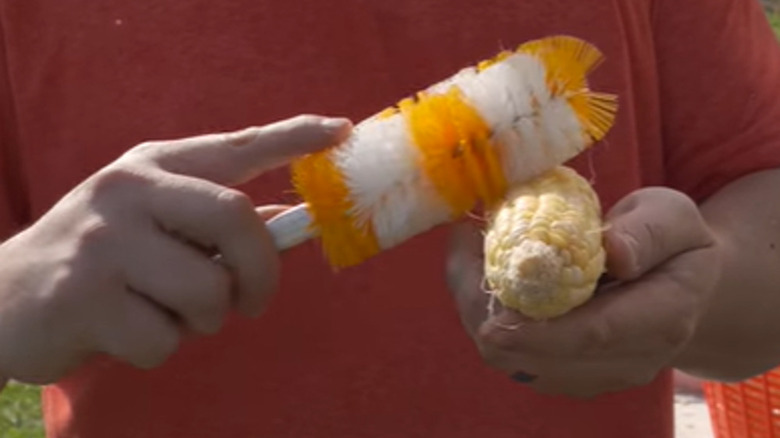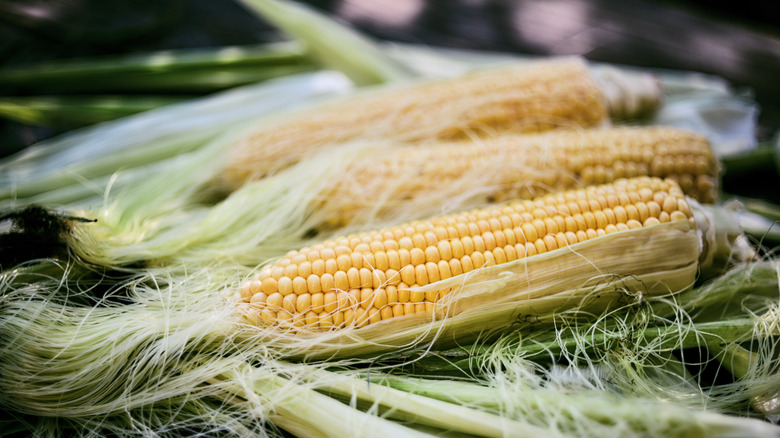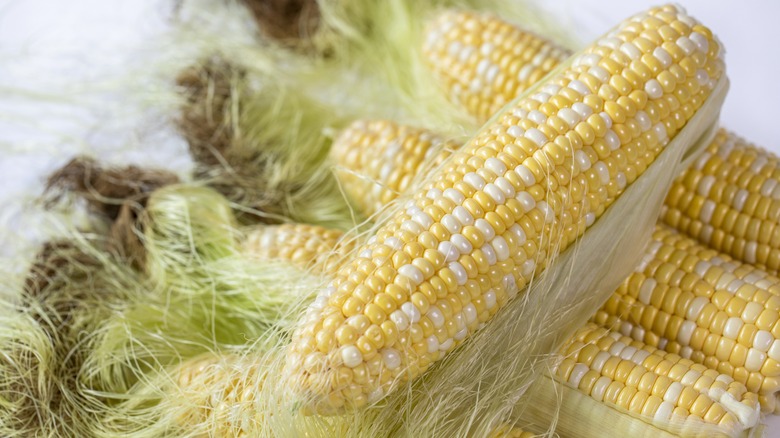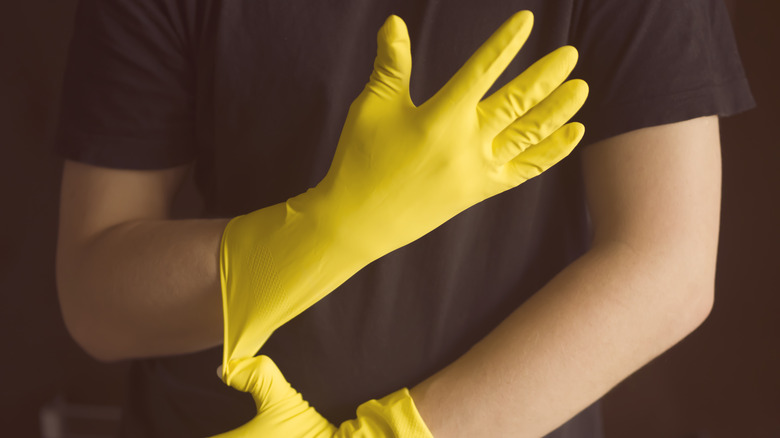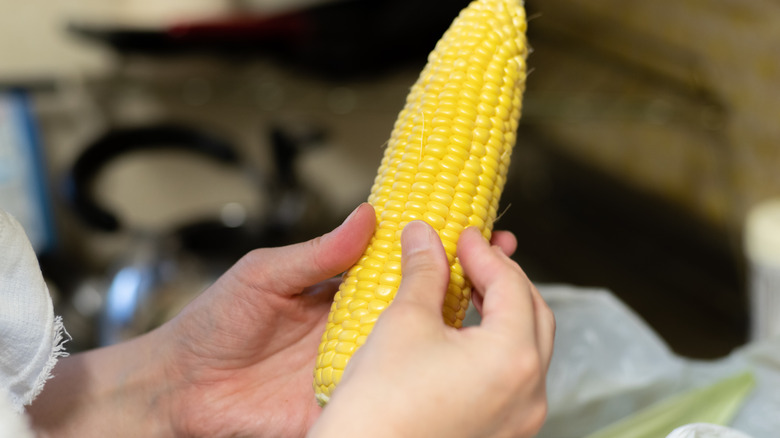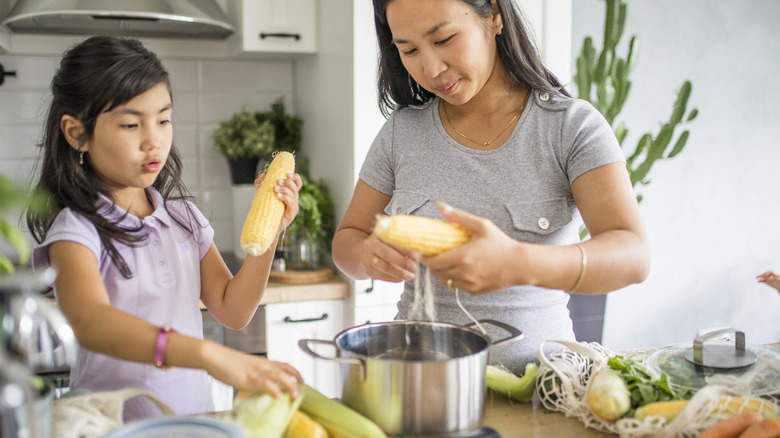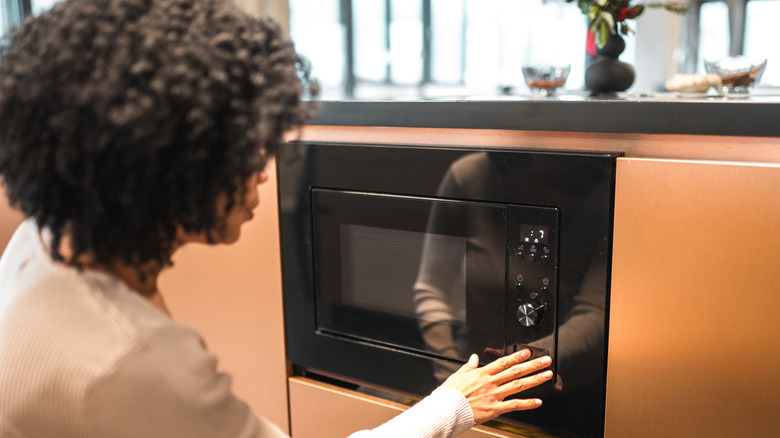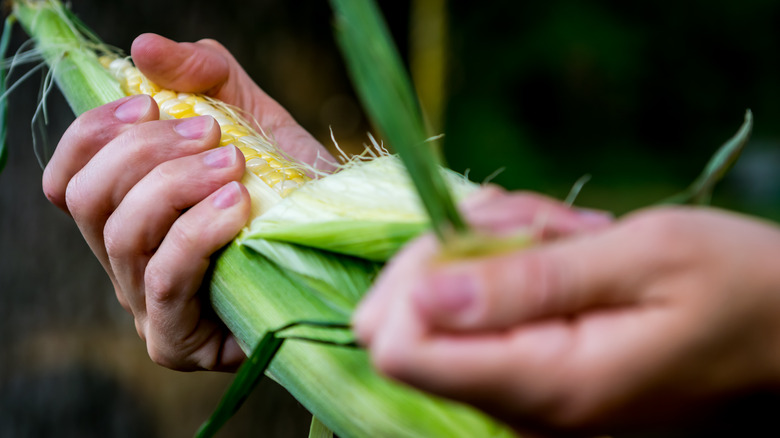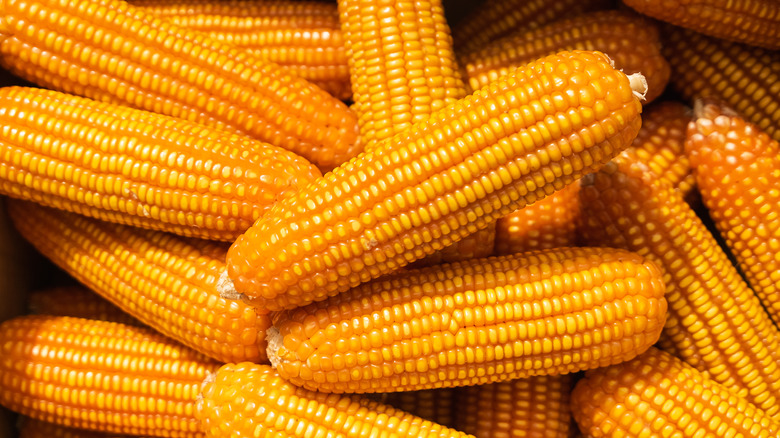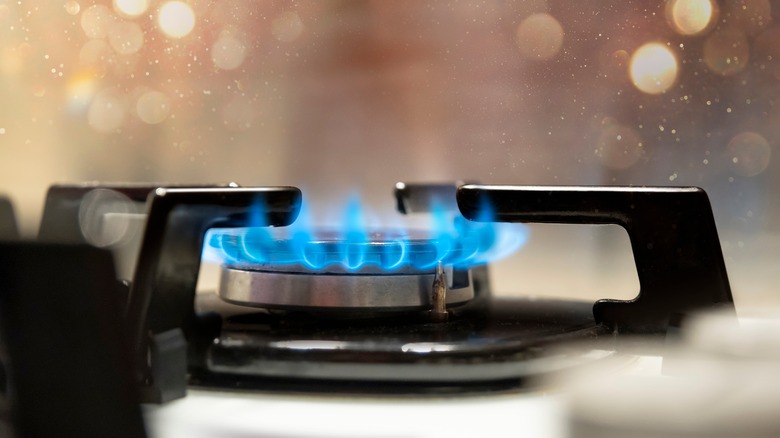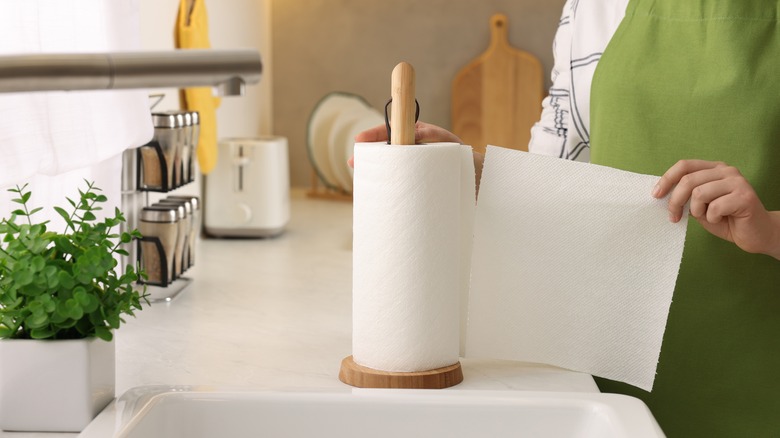Corn Shucking Hacks You'll Wish You Knew Sooner
Are you tired of struggling with corn shucking every time you decide to enjoy this delicious summer staple? Perhaps you're sick of spending precious minutes picking fine bits of silk off the cob when you could be using that time eating corn. Well, you're not the only one — shucking corn is a pain in the cob for most home cooks, but it needn't be. In this article, we're going to unveil some ingenious corn shucking hacks that will make you wonder how you ever managed without them. Say goodbye to those frustrating moments of tearing and tangling, and say hello to a quicker, cleaner, and more efficient way of getting those golden kernels ready for your next feast.
Corn on the cob is a classic favorite, but let's admit it — removing those pesky husks can be a bit of a hassle. That's where these tried-and-true hacks come into play. We'll be covering plenty of ground, including techniques such as the microwave hack and the gripper pad method. We'll share all the details you need to make your meal prep a breeze.
So, whether you're gearing up for a backyard barbecue, a cozy indoor dinner, or just a quick solo snack, these corn shucking hacks are about to revolutionize the way you enjoy your corn on the cob. Get ready to save time, minimize mess, and maximize your corn-eating pleasure — all thanks to these genius hacks you'll wish you'd known ages ago.
The brush technique
Ever find yourself locked in a battle with stubborn corn silk? Well, fret not, because there's a clever corn shucking hack that involves an everyday tool — a brush. You've got your fresh corn, ready to be stripped of its clingy silk. Instead of picking away at it with your fingers and struggling to keep your patience intact, reach for a kitchen brush. It's time to put that multitasking brush to work in a whole new way. You can buy dedicated corn husking brushes, but it's also fine to use other kitchen brushes, such as vegetable scrubbing brushes or basting brushes. You can even use a clean toothbrush.
So, how exactly do you use a brush to aid your corn shucking? Well, you start by removing the husk in the normal way, pulling off as much of the silk as possible off the cob. Then, get your brush to remove the residual silk. Work from top to bottom, letting the bristles glide down the cob. A few swipes should do the trick, but if your cob is particularly stubborn, don't hesitate to give it a few more gentle strokes. Your corn is now silk-free and ready to be roasted, grilled, or boiled to perfection. What's more, the silk tends to stick to the brush, making clean-up a breeze. No more picking silk out of your nails or wondering how it managed to get everywhere in your kitchen.
The microwave hack
You shouldn't buy pre-shucked corn, but that doesn't mean removing the husk is easy. How about we introduce you to a corn shucking hack that involves your trusty microwave? Yep, that magical box that warms up leftovers and pops popcorn can now make your corn shucking experience a whole lot smoother. Start by grabbing a corn cob (or a few, no judgment here), and resist the urge to start peeling off those husks. Instead, trim off the stalk end, including a few rows of kernels, and pop the whole thing — husk, silk, and all — into the microwave.
Blast the cobs for around 2 minutes. You're basically steaming the corn inside its own husk, which works some kind of kitchen magic. When the time's up, be cautious because that corn will be hot to the touch. Use oven mitts or a towel to handle it. Once you've got the hot corn in hand, give it a shake. It sounds strange, but with a firm shake, you can send the corn sliding right out of the husk (onto a waiting plate or cutting board), leaving you with a beautifully shucked ear of corn.
Not only does this hack save you from the husk-removal wrestling match, but it also steams the corn slightly. You aren't cooking it fully, but you're giving it a little head start, reducing the cooking time of whatever method you decide to use to prepare it.
The gripper pad method
Alright, let's talk about one of those kitchen hacks that's so simple that you'll be wondering why you didn't think of it sooner. You know those gripper pads you keep in your kitchen to wrestle open stubborn jar lids? Well, it turns out they're not just one-trick ponies — they can also be your trusty sidekick in the battle against clingy corn silk. So, here's the deal — you've got your corn, and you've roughly removed the husk, but there are stubborn silk strands hanging on. Instead of resorting to a time-consuming situation where you remove them one by one, grab one of those gripper pads. They're about to become your secret weapon in the world of corn shucking.
Hold your corn cob firmly in one hand, and in the other, grab the gripper pad. Wrap the gripper pad around the corn and give it a gentle but firm rub. The texture of the pad does wonders at dislodging the silk from the cob. Think of it as a little massage for your corn, minus the spa music and essential oils. As you move the gripper pad up and down the cob, you'll see the silk getting caught up in its textured surface. It's like a magnet for those annoying strands. So, in just a matter of seconds, your corn will be ready to cook without a strand in sight — all thanks to a little bit of kitchen ingenuity.
The rubber glove approach
If you don't have a gripper pad, there's a similar hack that uses something found in most kitchens — rubber gloves. Most people have rubber gloves for cleaning, dishwashing, and other household tasks. Well, it turns out they can help tackle annoying corn silk, too. After you've taken the husk off your corn, you're inevitably left with some silk. Instead of trying to pick it off one strand at a time, here's what you do.
Grab a clean rubber glove — one that's not been through any heavy-duty cleaning sessions, mind you. You don't want to make it dirty or transfer any cleaning chemicals onto it, so a fresh rubber glove or one that's just been used for washing dishes is best. Put the glove on one hand and hold the base of your corn cob with the other. Gently start sliding your gloved hand down the cob, following the curve of the kernels. The rubber texture of the glove helps get rid of the silk, coaxing it to jump ship from the corn and latch onto the glove instead. Before you know it, your corn will be silk-free, and you'll be left wondering why you didn't try this rubber glove trick ages ago. So, remember that your rubber gloves aren't just for cleaning, they're also your ticket to a hassle-free corn shucking experience. Just wait to shuck your corn until you're ready to use it in whatever way you choose. It'll stay fresher that way.
The rubber band process
You've got your corn, and so far, you've removed most of the husk. We all know by now that it's those determined silk strands that are the real problem. Instead of wrestling with them using just your fingertips, you can use a rubber band. If you want to try the rubber band hack, you first wrap the band around your hand. Make sure it's snug but not too tight — comfort is the key here. It might just go around your hand once or possibly twice if it's a large band.
Now, pick up your corn with your free hand and slide your rubber-banded hand down the cob. The rubber band's texture manages to tangle the silk along with it, removing it from the cob with very little muss and fuss. It's oddly satisfying to watch those silk strands give up their grip. In no time, you'll have silk-free corn, ready for whatever culinary masterpiece you're about to create. Then, you can just toss the rubber band and the silk it's collected straight into the trash. It's a straightforward hack, but it does the job with surprising efficiency.
The boiling water system
Alright, let's talk about a nifty corn shucking hack that involves a pot, water, and some good ol' boiling action. You might be used to peeling off the husk before cooking, but what if we told you that boiling the corn in its husk could actually make your life easier? Intrigued? Here's the game plan: take your fresh corn — husk and all — drop it into a pot of salted boiling water, and let it simmer away for about 5 to 8 minutes. The husk acts as a protective shield, allowing the corn to steam inside and get tender and delicious.
Once the time's up, carefully fish out the corn from the hot water. You might want to use some tongs for this part to avoid scalding yourself. Once the corn is cool enough to handle, simply pull the husk and silk away starting at the top of the ear. You'll find it all peels off without leaving any silk behind. Who knew that a pot of boiling water could be your ally in the battle against clingy husks? Give it a try, and you'll be enjoying your corn with a side of kitchen wisdom. Plus, the added bonus — cooking the corn inside the husk enhances the flavor, too.
The microwave and slide technique
We've already featured one microwave hack for shucking corn, but this one is slightly different because it comes with a sliding technique that some people find easier and more effective than shaking the corn from the husk in our other microwave trick. Whichever one you choose, your microwave is about to become your BFF this corn season.
You start by grabbing your ears of corn and sticking them in the microwave with the husk still firmly in place. Press a few buttons or turn a dial, and nuke your corn for 4 minutes if you're dealing with just one cob, or 8 minutes if you want to cook two cobs at once. Carefully cut an inch or two off the root end of your corn while using a kitchen towel or pot holders to keep yourself from getting scalded — corn might be delicious, but it isn't worth burning yourself over. Then, start to squeeze the corn from the other end of the husk, the way you might squeeze toothpaste out from the bottom of the tube. As you squeeze, the corn slides out from its husk, leaving all the silk behind. Your corn is not only husked, but cooked and ready to eat.
The split and pull method
The split and pull method is a corn shucking hack that requires nothing but your bare hands. It's all about precision and a bit of finesse, so it might take you a few tries to get it just right. Here's the trick: instead of wrestling with the husk, start by focusing on the tassel end — that's the hairy bit on top.
Start by holding the corn with the stem end pressed firmly against your hip. Next, take a good look at that tassel. Your mission is to carefully split the silk at the tassel. Your fingers are your tools here — gently maneuver them into the silk, making sure you've got a good grip. The idea is to grab all those fine strands in one go. Once you've got a solid hold on the silk and the leaves of the husk, with about half in each hand, give each side a firm but controlled pull toward you.
Do it right and you'll remove all of the husk and the silk in a couple of smooth motions. There's no need for any tools or equipment, just your trusty hands. Sure, you probably won't get it exactly right the first time, but you can use one of our other hacks to get rid of those last bits of silk. And, after a few goes, you'll be shucking corn perfectly every time.
The shelf liner tactic
We're all about innovative hacks to save you time and effort and — guess what? There's a corn shucking hack that involves a humble piece of shelf liner. You know, that grippy textured stuff you use to keep things from sliding around on your shelves. If you want to try this hack, first grab a clean piece of shelf liner. The kind with a grippy texture is key here. Remove the husk from your corn the normal way, and use the shelf liner to remove those leftover strands of silk.
Hold the end of your corn in one hand and the shelf liner in the other. Then wrap your hand that's holding the shelf liner around your corn, and rub it up and down the cob. The grippy texture of the liner dislodges the silk. As you rub, watch the silk strands get caught up in the texture. Before you know it, your corn cob is looking silk-free and ready for its close-up.
So, next time you're faced with a cob covered in clingy silk, remember that you don't need fancy gadgets or complicated techniques. A simple piece of grippy shelf liner can make the corn shucking process a breeze. Then all you need to focus on is which delicious corn recipe you're going to use your corn in.
The gas burner hack
Here's a hack for shucking corn that's got a touch of kitchen magic to it. You've got your corn and removed the main part of the husk, but those stubborn silk strands are putting up a fight. There's no need to resort to removing them by hand because your gas burner has your back on this corn shucking mission. Fire up your gas burner and simply hold your cob of born over the flame. Hold it by the far end or use tongs, especially for smaller cobs, to avoid burning yourself. Focus on the areas where the silk is still hanging around like unwelcome guests. The heat from the flame chars those clingy strands to oblivion.
As you hold the corn over the flame, you'll start to see the silk turning brown and curling up. Move the corn around, making sure all sides get their fair share of the flame's attention. But be careful — you don't want to end up with corn-on-the-cob-shaped charcoal. Once you're satisfied with the charred silk situation, take the corn off the flame, and let it cool for a moment. Then, give it a little shake or a gentle rub, and you'll see the charred silk falling away like magic. What you're left with is a clean, silk-free corn cob that's ready for action. But here's the best part — the brief encounter with the flame imparts a subtle smokiness to the corn, giving it an extra layer of flavor that's downright delicious.
The moist paper towel trick
We have a corn shucking hack for you that's as simple as it is effective. You've already tackled the husk, but those last few stubborn silk strands are playing hard to get. No worries because all you need for this trick is a humble wet paper towel. After you've removed the husk, dampen a paper towel with water — not sopping wet, just nicely damp. Now, hold the corn cob in one hand, and take the damp paper towel in the other. Give the cob a few gentle rubs with the damp paper towel, focusing on the areas where the silk is still hanging around.
The moisture from the paper towel attracts those silk strands, coaxing them to let go of their hold. Keep rubbing the damp paper towel over the cob, and you'll notice the silk strands sticking to the paper towel. Once the paper towel has worked its magic, you can just throw it in the trash or on your compost pile.
